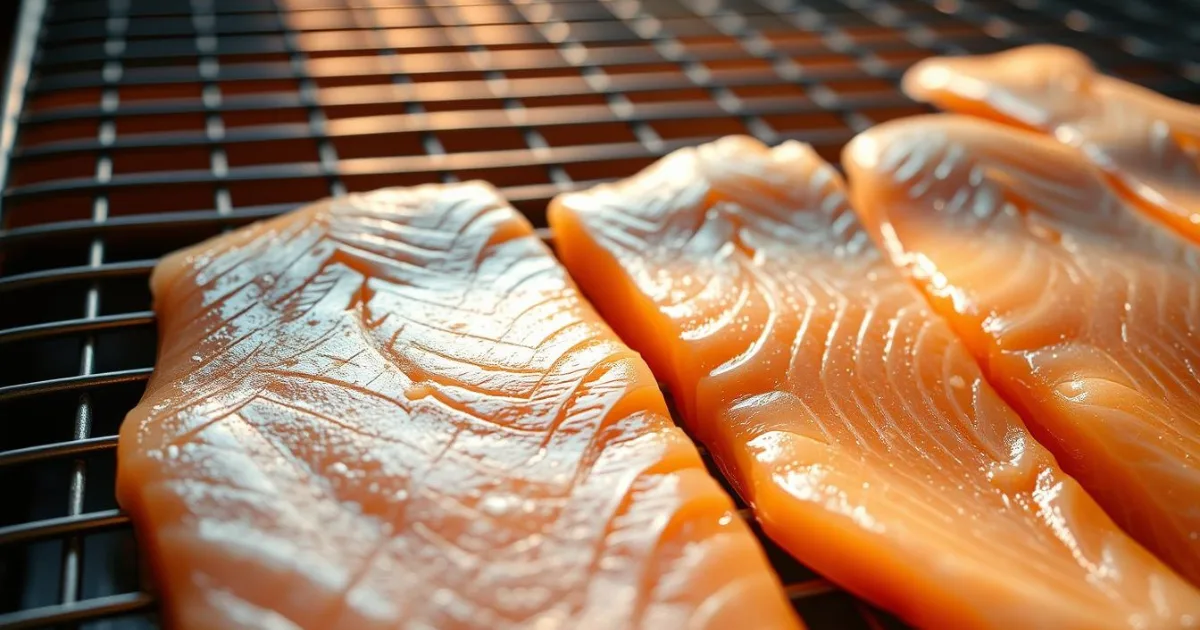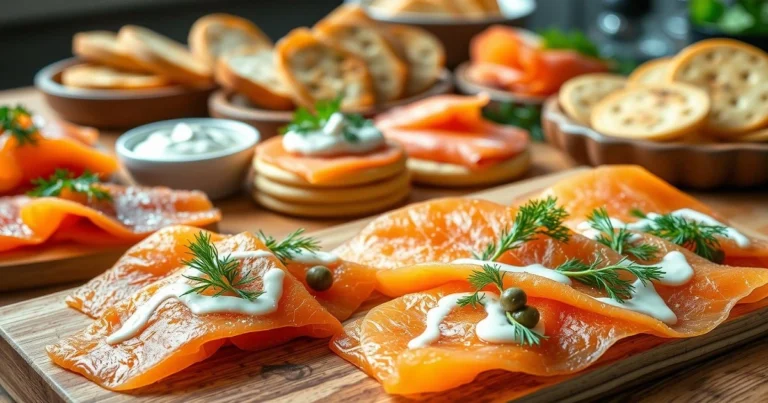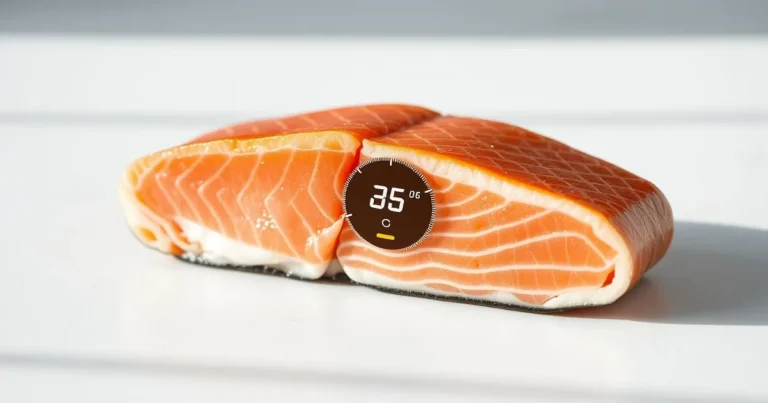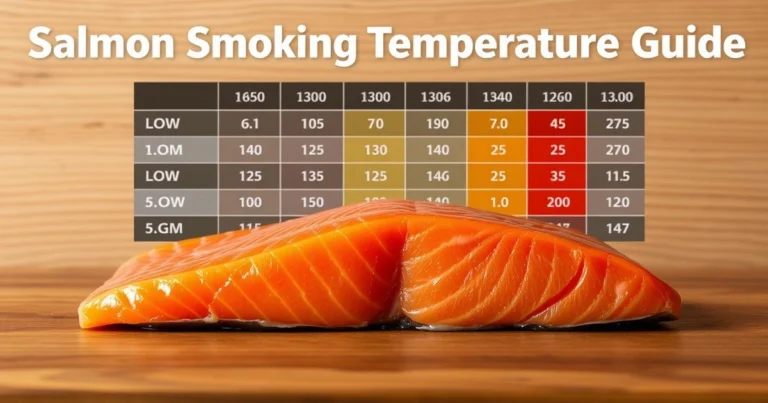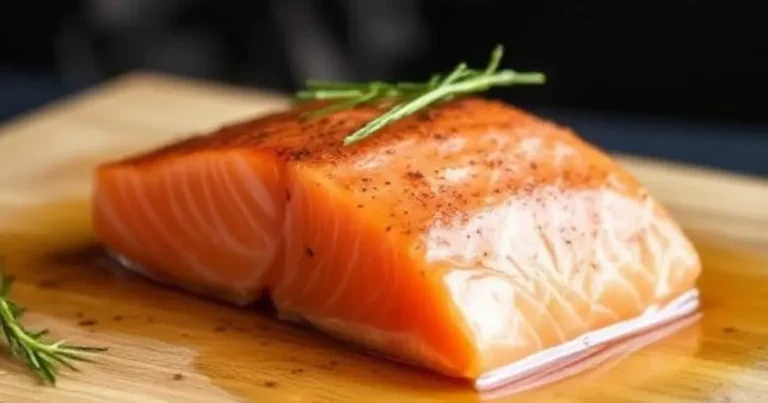Step-by-Step Guide: How Do You Smoke Salmon at Home?
how do you smoke salmon
Smoking salmon at home turns a simple fish into a gourmet dish. It takes precision, patience, and a love for seafood to make it right. This guide will show you how to make smoked salmon that rivals restaurant quality, all from your kitchen.
Smoking salmon is more than cooking—it’s an art that keeps flavors rich and enhances the fish’s natural taste. Whether you’re a home cook or a food lover, learning to brine smoked salmon will boost your skills. It will also wow your friends and family.
Table of Contents
Understanding the Art of Smoking Salmon
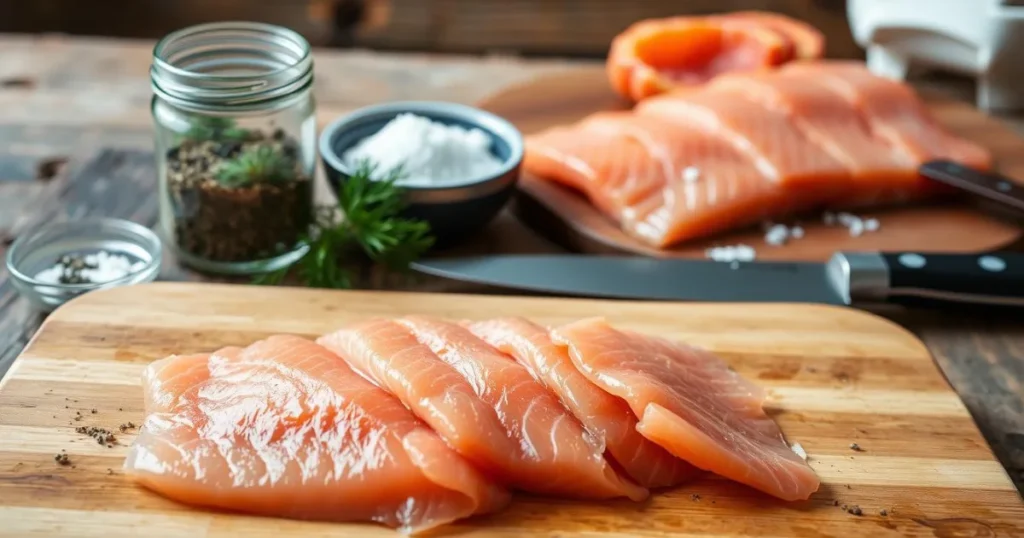
Smoking salmon turns fresh fish into a tasty treat. Learning how to smoke salmon reveals two main methods. These methods give salmon different tastes and textures.
Hot Smoking vs Cold Smoking Methods
There are two main ways to smoke salmon. Each method offers a special way to enjoy smoked salmon:
- Hot Smoking: Cooks the salmon at 120-180°F. It cooks the fish and adds smoky flavor.
- Cold Smoking: Keeps raw salmon cool below 90°F. It makes the salmon silky without cooking it.
The Science Behind Smoke Flavor
Smoke flavor comes from wood and salmon proteins reacting. Different woods add unique tastes. This makes every smoke session special.
| Wood Type | Flavor Profile | Intensity |
| Apple Wood | Sweet, mild | Light |
| Alder | Subtle, delicate | Medium |
| Mesquite | Strong, bold | High |
Traditional Preservation Techniques
Old smoking ways were key before fridges. Salt curing and slow smoking preserved fish. They also made the salmon taste better and last longer.
Essential Equipment and Tools for Smoking Salmon
Smoking salmon at home needs special equipment for the best taste and texture. Knowing how to smoke salmon right is easier with the right tools.
- Smoker or grill (charcoal, gas, or electric)
- Wood chips (cherry or apple recommended)
- Instant-read thermometer
- Cooling rack
- Deep-sided baking dish
- Aluminum foil
- Nonstick spray
Choosing the right smoker is key for the perfect smoked salmon. Each smoker has its own benefits:
| Smoker Type | Pros | Wood Chip Quantity |
| Charcoal Grill | Traditional flavor, high heat control | 1 cup wood chips |
| Gas Grill | Consistent temperature, easier to manage | 1½ cups wood chips |
| Electric Smoker | Precise temperature regulation | ½-1 cup wood chips |
For the best results, get a high-quality instant-read thermometer. It helps keep an eye on the salmon’s temperature. A vacuum sealer also helps keep smoked salmon fresh longer and tasting better.
Selecting the Perfect Salmon for Smoking
Choosing the right salmon is key when learning to smoke it. The quality of your fish affects the taste and texture of your smoked salmon. Not all salmon is the same, and knowing the differences can improve your smoking skills.
Farm-Raised vs Wild-Caught Salmon
You’ll find two main types of salmon: farm-raised and wild-caught. Wild-caught salmon is better for its taste and health benefits. Each type adds its own special touch to your smoked salmon.
- Wild-caught salmon offers more robust flavor
- Farm-raised salmon provides consistent quality
- Wild salmon tends to have firmer texture
Quality Indicators to Consider
Choosing high-quality salmon needs careful checking. Look for fish with:
- Bright, clear color
- Firm, resilient flesh
- Clean, ocean-like smell
- No discoloration or bruising
Best Salmon Varieties for Smoking
| Salmon Variety | Flavor Profile | Fat Content |
| King Salmon | Rich, buttery | High |
| Pink Salmon | Light, delicate | Low |
| Sockeye | Intense, robust | Medium |
| Coho | Mild, balanced | Medium |
Pro tip: Remove pin bones before smoking to ensure a smooth, enjoyable eating experience when preparing your smoked salmon dishes.
How Do You Smoke Salmon: The Complete Process
Smoking salmon at home needs precision and patience. It turns fresh salmon into a tasty treat through careful steps and cooking. Knowing how to smoke salmon means mastering key steps for flavor, texture, and safety.
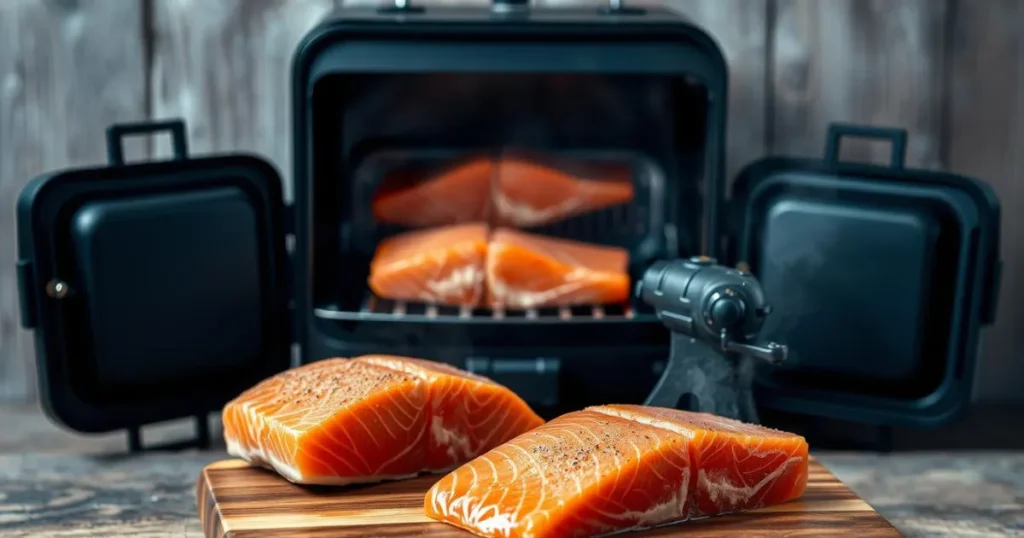
Smoking Salmon Preparation Steps
- Prepare the Brine Solution
- Mix 1 gallon cool water
- Add 1 cup kosher salt
- Include 1 cup brown sugar
- Add 1/4 cup lemon juice
- Brining Process
- Submerge salmon in brine
- Allow 1 hour per pound of fish
- Refrigerate during brining
- Pellicle Development
- Rinse salmon thoroughly
- Pat dry completely
- Place on wire rack
- Let dry for 2 hours until tacky surface forms
Temperature control is key when smoking salmon. You aim for an internal temperature of 145°F for safety. Start at 150°F for the first hour, then up to 180°F. Smoking usually takes 4-6 hours.
| Smoking Parameter | Recommended Setting |
| Initial Temperature | 150°F |
| Final Smoking Temperature | 180°F |
| Total Smoking Duration | 4-6 hours |
| Target Internal Temperature | 145°F |
Choosing the right wood is crucial for flavor. Apple, cherry, alder, and pecan woods add mild, nice tastes. Stay away from strong woods like hickory, as they can mask salmon’s flavor.
Pro tip: Use a meat thermometer to check the salmon’s internal temperature. This ensures it’s cooked perfectly and safe to eat every time.
Creating the Perfect Brine Solution
Learning to make a great smoked salmon brine is key to smoking salmon well. This process turns regular fish into a tasty treat that will wow your loved ones.
When making your smoked salmon brine, you can choose between dry and wet brining. Each method has its own benefits for making tasty salmon.
Dry Brine Method
The dry brine method involves covering your salmon with a mix of seasonings. Here’s a simple recipe:
- 1 cup coarse salt
- 2 cups brown sugar
- 1 tablespoon black pepper
- 1 tablespoon onion powder (optional)
Apply a thick layer of this mix to your salmon fillets. Let it sit in the fridge overnight or for at least 8 hours. The salt and sugar will pull out moisture and add amazing flavor.
Essential Brining Ingredients
The ingredients in your smoked salmon brine are vital for rich flavors. The main ones are:
- Kosher salt (for curing)
- Brown sugar (for balance and caramelization)
- Optional spices like black pepper or herbs
Optimal Brining Times
How long you brine depends on your salmon’s thickness. Usually, 4-12 hours is good for most fillets. After brining, rinse off extra salt, dry, and let the salmon rest. This helps it develop a protective layer before smoking.
Developing the Pellicle: A Crucial Step
Salmon Pellicle Formation Process
Learning to smoke salmon means mastering the pellicle technique. This sticky layer forms on the salmon after brining. It’s key for absorbing smoke.
To get a great pellicle, follow these steps:
- Pat the salmon dry with paper towels after brining
- Place salmon on a cooling rack in a cool, well-ventilated area
- Ensure ambient temperature remains under 65°F (15°C)
- Allow 1-4 hours for optimal pellicle formation
Drying is crucial. A good pellicle seals in moisture and helps smoke stick. A small fan can speed up drying and improve air flow.
| Pellicle Formation Factors | Recommended Conditions |
| Drying Time | 30-60 minutes minimum, 3 hours ideal |
| Temperature | Under 65°F (15°C) |
| Airflow | Cross-breeze or small fan recommended |
A perfect pellicle looks slightly tacky and shiny. This thin layer boosts flavor and texture. It makes your smoked salmon taste professional.
Wood Selection and Smoke Management
Learning how to smoke salmon is all about the wood and smoke control. The right wood can make your smoked salmon dishes amazing. It adds flavors that go well with the fish’s taste.
Best Wood Types for Salmon
Choosing the right wood is key when smoking salmon. Each wood type brings its own flavor that can make your dish better:
- Alder Wood: The classic choice for salmon, providing a mild and slightly sweet smoke
- Apple Wood: Adds a subtle, fruity sweetness to your smoked salmon dishes
- Cedar: Imparts a rich, woodsy flavor that pairs beautifully with salmon’s natural oils
- Oak: Delivers a medium-strong smoke that doesn’t overpower the fish
Smoke Intensity Control
Controlling the smoke’s intensity is an art. Too much smoke can hide the salmon’s flavor. Too little, and it tastes bland.
“The key is balance – your wood should whisper, not shout” – Culinary Smoking Expert
Here are some tips for managing smoke intensity:
- Use fewer wood chips for a lighter smoke flavor
- Mix wood types to create complex flavor profiles
- Monitor temperature and smoke density carefully
- Start with milder woods and experiment gradually
By mastering wood selection and smoke control, you’ll make your smoked salmon truly exceptional.
Temperature Control and Cooking Times
Mastering the art of smoking salmon requires precise temperature management. You’ll want to keep the temperature between 225°F to 275°F during the smoking process.
It’s important to know the internal temperature of smoked salmon. Your goal is to create a perfect balance of flavor and texture. This turns ordinary salmon into a gourmet delicacy.
- Start smoking at 140°F to 150°F for the first hour
- Finish smoking at 175°F during the final hour
- Target internal temperature: 130°F to 140°F
Different salmon varieties need slightly different approaches. Wild salmon typically reaches its optimal point at 120°F, while farm-raised salmon does best at 125°F. Use a reliable meat thermometer to track these precise temperatures.
| Salmon Type | Smoking Temperature | Target Internal Temperature | Approximate Cooking Time |
| Wild Salmon | 225°F – 275°F | 120°F | 50-75 minutes |
| Farm-Raised Salmon | 225°F – 275°F | 125°F | 50-75 minutes |
Pro tip: Keep a water or ice drip pan in your smoker to help regulate temperature and prevent the salmon from drying out. Baste your fish every hour with birch or maple syrup to enhance flavor and moisture.
Monitoring Internal Temperature and Doneness
Getting the perfect internal temperature is key when smoking salmon. Knowing the right temperature ensures both safety and great taste. It requires precision and careful watching.
The internal temperature of smoked salmon is very important. It affects the texture, taste, and safety of the fish. Different types of salmon need specific temperatures to be at their best.
Target Temperature Guidelines
- Wild Salmon: Aim for 135°F (57°C) for tender, moist results
- Farm-Raised Salmon: Target 145°F (63°C) for complete food safety
- USDA recommended safe internal temperature: 145°F (63°C)
Signs of Perfectly Smoked Salmon
Knowing when your salmon is perfectly smoked is more than just checking the temperature. Look for these signs:
- Consistent pink color throughout
- Flaky texture that separates easily
- No translucent areas in the flesh
- Firm but not dry appearance
“The difference between good and great smoked salmon is often just a few degrees.” – Professional Salmon Smoker
Remember, the fish will cook a bit more after it’s out of the smoker. It can get up to 5°F (3°C) hotter. So, take it out a bit before it hits your target temperature.
Keep your smoker at 150-175°F (65-80°C) to avoid overcooking. This ensures the salmon stays moist and flavorful. Patience and a good meat thermometer are essential for perfect smoked salmon.
Storage and Preservation Methods
Learning how to smoke salmon is just the start. Keeping it fresh is key to enjoying its taste and texture. There are several ways to preserve smoked salmon, making it last longer.
Refrigeration is the main way to store smoked salmon. Cold-smoked salmon stays good for 7-10 days in the fridge. Wrap it tightly in plastic or use an airtight container to keep it fresh.
Preservation Techniques
- Vacuum sealing extends shelf life and prevents air exposure
- Use clean, airtight containers for storage
- Keep refrigerated at or below 40°F
Freezing is great for keeping smoked salmon for longer. Properly packaged smoked salmon can be frozen for up to two months without significant flavor loss. Here’s how to freeze it right:
- Wrap salmon tightly in freezer-safe plastic wrap
- Place in a freezer-safe bag, removing excess air
- Label with the date of freezing
“Proper storage is the secret to maintaining the exquisite taste of homemade smoked salmon” – Culinary Experts
When you’re ready to use your frozen smoked salmon, thaw it slowly in the fridge. This keeps its texture delicate and prevents moisture loss in your dishes.
Conclusion
Learning to smoke salmon at home turns your kitchen into a gourmet spot. You’ve learned how to make tasty smoked salmon dishes, just like the pros. It takes precision, patience, and passion to get it right.
Smoking salmon is more than cooking; it’s an art that boosts flavor and keeps fish fresh. Choosing the right salmon and controlling smoker temperatures are key. Your homemade smoked salmon can make any dish better, adding smoky taste and health benefits.
Getting better at smoking salmon takes time. Try different woods, brines, and smoking times to find your style. Use a Thermoworks Smoke Pro Series thermometer for perfect results every time.
Smoking salmon at home is more than a meal; it’s a rewarding journey. It connects you with old preservation ways and makes healthy, tasty dishes for your loved ones.
FAQ
What’s the difference between hot smoking and cold smoking salmon?
Hot smoking cooks the salmon and adds smoke, at 120-180°F. Cold smoking keeps it raw, below 90°F. Hot smoking makes it flaky, while cold smoking keeps it delicate.
How long should I brine salmon before smoking?
Brine time varies with salmon thickness. For average fillets, 4-8 hours is good. Thinner pieces need 2-4 hours, and thicker ones up to 12 hours. Don’t over-brine to avoid saltiness.
What internal temperature indicates that smoked salmon is fully cooked?
For safety and texture, aim for 145°F. But, some prefer 135-140°F to keep it moist. The temperature will rise a bit after removing from heat.
Which wood types work best for smoking salmon?
Alder is top for salmon, with a sweet flavor. Apple and cherry woods offer a lighter smoke. Oak is stronger. Avoid mesquite for its bitter taste.
How long can I store homemade smoked salmon?
Smoked salmon lasts 3-4 days in the fridge, sealed. Vacuum-sealed, it’s 1-2 weeks. Frozen, it’s up to 3 months.
Do I need a special smoker to smoke salmon at home?
A dedicated smoker is best, but alternatives work too. Use a charcoal grill, gas grill with a smoke box, or a modified oven. Keep temperatures low and smoke consistent.
What’s a pellicle, and why is it important?
A pellicle is a tacky layer on the salmon after drying. It helps smoke stick better and intensifies flavor. Air-dry the salmon for 1-2 hours to form a glossy surface.
Can I smoke farm-raised or wild-caught salmon?
Both can be smoked well. Wild-caught has a stronger flavor and firmer texture. Farm-raised is fattier, making it buttery. Choose fresh, high-quality fish.
Source links
- https://letthebakingbegin.com/smoked-salmon-without-a-smoker/
- https://iowagirleats.com/how-to-smoke-salmon/
- https://www.thekitchn.com/how-to-make-smoked-salmon-two-ways-cooking-lessons-from-the-kitchn-174543
- https://www.instructables.com/How-to-Smoke-Salmon/
- https://mgfalaska.com/how-to-smoke-salmon/
- https://www.americastestkitchen.com/articles/7494-how-to-hot-smoke-salmon
- https://laughingspatula.com/how-to-smoke-salmon/
- https://www.jerkyholic.com/smoked-salmon/
- https://dirtanddough.com/how-to-smoke-salmon/
- https://blackberrybabe.com/2016/10/23/brown-sugar-smoked-salmon/
- https://www.smoking-meat.com/july-2010-smoking-salmon
- https://www.theroastedroot.net/easy-smoked-salmon-recipe/
- https://www.hungryhuy.com/how-to-smoke-salmon/
- https://www.bradleysmoker.com/blogs/recipes-fish-seafood/smoked-salmon-recipe?srsltid=AfmBOorGNlHQIRCjANev2KR3K23v7db2F5OCIjxEqkSAUSEXDLB9Nxe1
- https://www.thecountrycook.net/perfect-smoked-salmon/
- https://eatcuredmeat.com/cold-smoking/how-to-form-a-pellicle-on-smoked-meat-why-is-it-awesome/
- https://www.plattertalk.com/how-to-smoke-salmon-recipe/
- https://aksalmonco.com/blogs/learn/make-smoked-salmon-at-home?srsltid=AfmBOoqifGSPaBPlXD-KaNWU0-9WW1LLUHhEJECQ7RjkCotMaYcGCIb2
- https://globalseafoods.com/blogs/recipes/smoked-salmon?srsltid=AfmBOopAUL2YKMncM9J2JBg9kbTt-_dnwUgbV8pNHCKrhWNcCsFTM9ky
- https://www.bradleysmoker.com/blogs/recipes-fish-seafood/smoked-salmon-recipe?srsltid=AfmBOooneZJ_VdHIVQriWdHgm_eMRjaQCc-O1NWMfHLAr5RGVULYl1Am
- https://honest-food.net/how-to-smoke-salmon-recipe/
- https://www.seriouseats.com/how-to-smoke-salmon-recipe-8621746
- https://blog.thermoworks.com/key-temps-smoked-salmon/
- https://www.vindulge.com/easy-tender-smoked-salmon-fillet-recipe/
- https://www.themeatplate.com/best-smoked-salmon-internal-temp/
- https://lostartskitchen.wordpress.com/2011/03/20/preserving-salmon-three-ways/
- https://www.markys.com/blog/best-way-to-store-and-preserve-smoked-salmon-for-later-use?srsltid=AfmBOoqi7zZhHT2ebUwPKmIq15BD0JhxeJGO0jXVgUVlF1YN-AG9ym6S
- https://riptidefish.com/how-to-smoke-salmon-alaskan-style/
- https://globalseafoods.com/blogs/recipes/smoked-salmon?srsltid=AfmBOooIUq-83PLxmMQdyAyIXdKXn6gufjeWzZ4kti6zJ8vGviTTZDi5
- https://whatscookingamerica.net/smokesalmon.htm
- https://www.chefstemp.com/smoked-salmon-key-temperatures/?srsltid=AfmBOopOCiVTgU-6rLGPLE-92_QHJAGhtSJDpbbz3mCoqkPHOoN8NAkL

